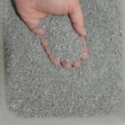26 Jan 2012
Fluid Sulphur Sources
Sulphur nutrition and fluid fertilisers
Dr Robert Edis and Dr Robert Norton
Presentation notes.
Sulphur is an essential element for plants and animals, and also for soil organic matter. Access to adequate supply of sulphur for plants through their development is necessary for optimum crop performance. Fluid forms of sulphur have a place in managing sulphur nutrition in many circumstances. The notes provided here will be expanded upon in-session.
1. Sulphur in the soil plant system
Role of sulphur in plants
Sulphur is an important part of a balanced plant nutrition program. Crops grown on sulphur deficient soils suffer reduced yield as well as poor product quality. Sulphur is present in the essential amino acids cystiene and methionine which cannot be synthesized by higher animals. Methionine is an initiating amino acid in many proteins, and cysteine plays a critical role in protein structure through the formation of disulfide bonds. Sulphur rich compounds have also been identified as conferring a range of flavour and health benefits including the organic compounds in garlic (allyl cysteine sulfopoxide) and onion (capenes and thiosulphates), and the glucosinolate compounds in brassicas.
Relative importance
Plants maintain a relatively constant ratio of organic nitrogen to organic sulphur (for wheat, the N:S ratio in grain is around 17). The relative proportions of nitrogen and sulphur determine protein structure and type, and this is one of the main reasons that sulphur nutrition affects grain and baking quality. A higher sulphur supply increases the glutenin content, which in turn affects bread making quality. Higher sulphur also leads to more glucosinolate.
Forms of sulphur used by plants
Plants take up sulphur almost exclusively as sulphate (SO42-) anions from the soil solution. Some sulphur can be assimilated as gaseous sulphur dioxide (SO2) or hydrogen sulfide (H2S) through leaves where serious air pollution is present. Sulphate is actively taken into the roots, and then transported through the plant mostly unmetabolized and is ultimately either directly incorporated into plant metabolites or reduced and incorporated into cysteine to then go into other metabolic pathways. Under S-limiting conditions, the efficiency of remobilization of vacuole stored sulphate and other pools of reduced sulphur can be low, so that during later growth or grain filling, low tissue sulphur contents may result. Typically, therefore, the symptoms of sulphur deficiency occur first in the younger tissues and are seen as leaves and veins turning pale green to yellow. These symptoms are similar to those of nitrogen deficiency but symptoms nitrogen deficiency are more obvious in the older tissues first.
Forms of sulphur in soil
Most of the sulphur in soil is present in organic matter, which has to be mineralized to release sulphate for plant uptake. The ratio of organic carbon:sulphur is approximately 100C:1S. Also in acid-sulphate soils, sulfides (S2-) can predominate, and significant sulphate as gypsum can be present in arid soils or soils where large additions of gypsum have been made.
In the soil solution, sulphate is highly mobile and only weakly held on colloidal particles. It is easily leached and so can move out of the root zone of crops and pastures, and losses of up to 100 kg S ha-1 have been measured at in southern England.
Sulphate is also taken into microorganisms and plants to become fixed then into soil organic matter. The assimilation of sulphate to organic sulphur in the soil micro-flora (immobilization) temporarily diminishes sulphate availability to plants (and to loss pathways), similar to nitrogen.
Sulphur cycling in soil plant system
The inputs of sulphur to soil that provided initial sulphur capital varies between environments and includes historical marine intrusions, groundwater discharge, volcanism, and wind blown gypsum from arid environments. More recent “unintended” additions have been from air pollution, sulphur containing agrichemicals, and bonus sulphur in superphosphate.
Due to absence, diminution or unavailability of capital sulphur, and a reduction of on-going unintended inputs, sulphur cycling in a crop is largely about organic matter mineralisation-immobilisation, topped up with intended inputs, and sulphur removal in product and leaching. The rate of supply of sulphur by mineralisation (organic matter breakdown) is dependant on moisture, temperature, disturbance and “soil health”.
Adequacy of supply, sulphur crop balances
As sulphur availability naturally is dependent on turnover of organic matter, the amount of organic matter present, and the rate of its breakdown determines adequacy of supply from this source. Where gypsum is present (for example from earlier additions), the solubility of gypsum is also important. Under conditions of cool soil (such as winter) and minimal disturbance (such as minimum tillage), organic matter breakdown may be too slow to provide adequate supply of sulphur (or nitrogen) to crops with high sulphur demand, even if abundant organic matter is present.
Removal of sulphur by crops also runs down the soils sulphur capital, and should be balanced by an input. Typical removal rates are: canola: 5 kg S/t grain (2 t crop removes about 10 kg S); wheat: 1.4 kg S/t grain (3 t crop removes about 4.2 kg S); chickpea: 1.8 kg S/t grain (3 t crop removes about 5.4 kg S), and; lentils: 1.4 kg S/t grain (2 t crop removes about 2.8 kg S). Of course, more sulphur than this is required to grow the rest of the plant!
Soil tests, adequacy and deficiency diagnosis
Nationally there appears to be more sulphur applied to Australian soils than removed. However, unavailability results in sulphur deficiencies being widespread, even where adequate phosphorus has been supplied by superphosphate. In a set of samples from New England, 46% of samples were below a critical phosphorus value, but 74% showed soil sulphur levels below the critical value. Data from 1200 samples collected across Victoria, South Australia and New South Wales through Nutrient Advantage soil testing laboratories found that 52% of cropping soils and 43% of pasture soils had sulphur status (KCl-40) less than 8 mg S/kg soil, indicating significant S deficiency.
Because of the importance of release of sulphur from organic matter during the growing season, soil tests are imperfect indicators. Potassium chloride extract at 40C (KCl-40) has become the laboratory standard, and though useful, the interpretation of results needs improvement for canola. Other tests and modeling approaches are likely to be developed, including analysis of deeper soil samples and simulation of mineralization of sulphur, similar to that which is done for nitrogen..
Deficiency symptoms in plants early in a season may be visible, and intervention effective due to the uptake pattern of sulphur by many plants. Deficiency signs are often similar to those of nitrogen though. Nevertheless, since sulphur and nitrogen usually come from the same source, there is a case of linking sulphur applications to those of nitrogen.
2. Sulphur management options in grain cropping systems
The development of fertilizer best management practices is a key to achieving yield improvement and maintenance, and this approach looks to apply the right source (or product) at the right rate, right time and right place, a strategy called the “4R’s Nutrient Stewardship Framework” by the International Plant Nutrition Institute. Additions of sulphur of course will only lead to benefits where the system is sulphur constrained or co-constrained, and will be wasted if the crop is constrained by factors such as other nutrient deficiencies, poor plant health, competition, or inhospitable growing media.
Selecting the right rate of fertiliser sulphur
Estimating the required rate of sulphur addition may be on the basis of soil tests.
Based on experimental work in Australia, Good and Glendinning suggested that where soil tests were low, 40 kg S ha-1 would be adequate for a good canola crop, while with higher soil tests, 20 kg S ha-1 would be recommended. Certainly as a minimum, sulphur removal in product should be balanced. Because nitrogen and sulphur are present in plants (crop specific ratios) and soil organic matter, there is an argument to link sulphur rates to nitrogen rates (about 0.16 kg S/kg N for canola, and about 0.08 kg S/kg N for wheat). Although sulphur is not added to the system through rotations, it is conceivable that available sulphur will increase during a phase with low sulphur demands that may assist meeting the requirements of a subsequent high sulphur demanding crop.
Selecting the right time and place for application
Sulphur is more forgiving of timing than nitrogen or phosphorus. For example similar yields can be achieved for canola on a deficient site with up-front or rosette stage applications of readily available sulphur. If the form of sulphur is less available, then more time is required. It may be, for example, that gypsum needs to be applied in the previous season to meet requirements of crops with high sulphur demand (though there is little data to show this). The right place for the fertiliser needs to be determined considering the timing and potential phytotoxic effects of the product.
Selecting the right product
The right product will be decided on by considering the needs of the crop, not only for sulphur but also for other nutrients and crop management interventions. Then the suitability, availability or cost of equipment needs to be considered. Where use of fluids is preferred, for reasons discussed elsewhere, then a sulphur containing fluid product should be considered, bearing in mind required rate of sulphur, compatibility with other constituents of the liquid and potential phytotoxicity.
3. Fluid sulphur fertiliser options
The main forms of sulphur in fluid fertilisers are sulphate (SO42- particularly as ammonium sulphate), and thiosulphate (S2O32-, particularly ammonium thiosulphate (ATS) or potassium thiosulphate (KTS)). Other less common products are bisulphites and polysulphides.
Thiosulphates; Ammonium thiosulphate, potassium thiosulphate
Ammonium thiosulphate (ATS) is the most concentrated fluid sulphur source, with 340 g S /L as thiosulphate and 160 g N/L as ammonium. Potassium thiosulphate is typically 170 g S/L and 200 g K/L. Both are often fortified with UAN to meet nitrogen targets. Compatibility with other products should be checked against compatibility lists. For example, thiosulphates are not stable in acidic solutions, such as with phosphoric acid.
Thiosulphate breaks down biologically after application eventually to sulphate, and this generates acidity. This conversion is generally complete after two weeks, though if the soil is cold up to 6 weeks. If ammonium is also applied, further acidity is generated through nitrification. Thiosulphate has been shown to reduce ammonia volatilization and nitrification (overseas data). Mobilization of trace elements, and enhanced phosphorus uptake has also been observed, probably as a result of the localized acidification.
Direct contact of plants or seeds with thiosulphate should be avoided, with placement at least 5 cm away from seeds and non-foliar applications recommended. Use of dribble bars, or side bed injection, are suitable for in-season application.
SARDI trials on red-brown sandy loam soil in 2003, found a fluid mixture of APP with UAN and ATS produced 31% more dry matter at mid tillering than MAP with UAN, but there were no grain yield differences.
Sulphates; Ammonium sulphate
The maximum concentration of sulphur in solution as sulphate is much less than can be achieved with thiosulphate. For example MAXamFLO (Summit Fertilizers); 284 g N/L as ammonium and urea, and 84 g S/L as sulphate. The lower phytotoxitcity though allows diluted foliar application.
On certain soil types, it has been shown that ammonium sulphate increases yield and nutrient recovery for canola when compared to urea and gypsum. On alkaline, poorly buffered soils, the acidification of the root zone may result in improved access to N and S, as well as extra P.
Conclusions
The two main fluid fertilizer options for sulphur nutrition are thiosulphates and sulphates, and with attention to compatibility and phytotoxicity constraints are useful tools in an integrated crop production package.
For more information about these and other plant nutrition options, visit the International Plant Nutrition Institute website (http://www.ipni.net/). In particular see the Nutrient Source Specifics series - http://www.ipni.net/specifics which has more information on the properties and applications for a range of fertilizers.
Additional Resources
Sulphur fluid sources.pdfSize: 0.08 MB




